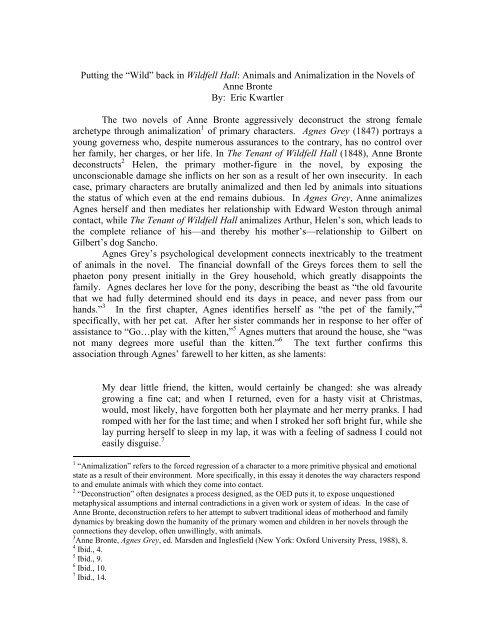The Secret Society: Descendants of Crypto-Jews in the San Antonio ...
The Secret Society: Descendants of Crypto-Jews in the San Antonio ...
The Secret Society: Descendants of Crypto-Jews in the San Antonio ...
You also want an ePaper? Increase the reach of your titles
YUMPU automatically turns print PDFs into web optimized ePapers that Google loves.
Putt<strong>in</strong>g <strong>the</strong> “Wild” back <strong>in</strong> Wildfell Hall: Animals and Animalization <strong>in</strong> <strong>the</strong> Novels <strong>of</strong><br />
Anne Bronte<br />
By: Eric Kwartler<br />
<strong>The</strong> two novels <strong>of</strong> Anne Bronte aggressively deconstruct <strong>the</strong> strong female<br />
archetype through animalization 1 <strong>of</strong> primary characters. Agnes Grey (1847) portrays a<br />
young governess who, despite numerous assurances to <strong>the</strong> contrary, has no control over<br />
her family, her charges, or her life. In <strong>The</strong> Tenant <strong>of</strong> Wildfell Hall (1848), Anne Bronte<br />
deconstructs 2 Helen, <strong>the</strong> primary mo<strong>the</strong>r-figure <strong>in</strong> <strong>the</strong> novel, by expos<strong>in</strong>g <strong>the</strong><br />
unconscionable damage she <strong>in</strong>flicts on her son as a result <strong>of</strong> her own <strong>in</strong>security. In each<br />
case, primary characters are brutally animalized and <strong>the</strong>n led by animals <strong>in</strong>to situations<br />
<strong>the</strong> status <strong>of</strong> which even at <strong>the</strong> end rema<strong>in</strong>s dubious. In Agnes Grey, Anne animalizes<br />
Agnes herself and <strong>the</strong>n mediates her relationship with Edward Weston through animal<br />
contact, while <strong>The</strong> Tenant <strong>of</strong> Wildfell Hall animalizes Arthur, Helen’s son, which leads to<br />
<strong>the</strong> complete reliance <strong>of</strong> his—and <strong>the</strong>reby his mo<strong>the</strong>r’s—relationship to Gilbert on<br />
Gilbert’s dog <strong>San</strong>cho.<br />
Agnes Grey’s psychological development connects <strong>in</strong>extricably to <strong>the</strong> treatment<br />
<strong>of</strong> animals <strong>in</strong> <strong>the</strong> novel. <strong>The</strong> f<strong>in</strong>ancial downfall <strong>of</strong> <strong>the</strong> Greys forces <strong>the</strong>m to sell <strong>the</strong><br />
phaeton pony present <strong>in</strong>itially <strong>in</strong> <strong>the</strong> Grey household, which greatly disappo<strong>in</strong>ts <strong>the</strong><br />
family. Agnes declares her love for <strong>the</strong> pony, describ<strong>in</strong>g <strong>the</strong> beast as “<strong>the</strong> old favourite<br />
that we had fully determ<strong>in</strong>ed should end its days <strong>in</strong> peace, and never pass from our<br />
hands.” 3 In <strong>the</strong> first chapter, Agnes identifies herself as “<strong>the</strong> pet <strong>of</strong> <strong>the</strong> family,” 4<br />
specifically, with her pet cat. After her sister commands her <strong>in</strong> response to her <strong>of</strong>fer <strong>of</strong><br />
assistance to “Go…play with <strong>the</strong> kitten,” 5 Agnes mutters that around <strong>the</strong> house, she “was<br />
not many degrees more useful than <strong>the</strong> kitten.” 6 <strong>The</strong> text fur<strong>the</strong>r confirms this<br />
association through Agnes’ farewell to her kitten, as she laments:<br />
My dear little friend, <strong>the</strong> kitten, would certa<strong>in</strong>ly be changed: she was already<br />
grow<strong>in</strong>g a f<strong>in</strong>e cat; and when I returned, even for a hasty visit at Christmas,<br />
would, most likely, have forgotten both her playmate and her merry pranks. I had<br />
romped with her for <strong>the</strong> last time; and when I stroked her s<strong>of</strong>t bright fur, while she<br />
lay purr<strong>in</strong>g herself to sleep <strong>in</strong> my lap, it was with a feel<strong>in</strong>g <strong>of</strong> sadness I could not<br />
easily disguise. 7<br />
1 “Animalization” refers to <strong>the</strong> forced regression <strong>of</strong> a character to a more primitive physical and emotional<br />
state as a result <strong>of</strong> <strong>the</strong>ir environment. More specifically, <strong>in</strong> this essay it denotes <strong>the</strong> way characters respond<br />
to and emulate animals with which <strong>the</strong>y come <strong>in</strong>to contact.<br />
2 “Deconstruction” <strong>of</strong>ten designates a process designed, as <strong>the</strong> OED puts it, to expose unquestioned<br />
metaphysical assumptions and <strong>in</strong>ternal contradictions <strong>in</strong> a given work or system <strong>of</strong> ideas. In <strong>the</strong> case <strong>of</strong><br />
Anne Bronte, deconstruction refers to her attempt to subvert traditional ideas <strong>of</strong> mo<strong>the</strong>rhood and family<br />
dynamics by break<strong>in</strong>g down <strong>the</strong> humanity <strong>of</strong> <strong>the</strong> primary women and children <strong>in</strong> her novels through <strong>the</strong><br />
connections <strong>the</strong>y develop, <strong>of</strong>ten unwill<strong>in</strong>gly, with animals.<br />
3 Anne Bronte, Agnes Grey, ed. Marsden and Inglesfield (New York: Oxford University Press, 1988), 8.<br />
4 Ibid., 4.<br />
5 Ibid., 9.<br />
6 Ibid., 10.<br />
7 Ibid., 14.
















